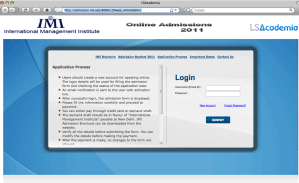Interview with Director of Admissions at IMI, Professor Himadri Das, featured on Pagalguy
December 7, 2010 Leave a comment
Following the diversity-wave hitting Indian b-schools, Delhi-based International Management Institute (IMI) too is comtemplating using relaxed CAT cut-offs for students from commerce, economics and arts backgrounds, says Admission Director Prof Himadri Das. In this interview, he also announces IMI’s thought process behind opening new campuses in Kolkata and Bhubhaneswar.
What can the incoming batch of 2011-13 can look forward to at IMI Delhi?
The new batch can look forward to an updated curriculum, keeping in mind the needs of the industry. For each functional area of management, we have industry advisory boards or councils whom we meet regularly to learn about the industry’s latest needs. The new batch can also look forward to a more vibrant corporate interface. Mr. Sanjiv Goenka who is the Chairman of the “Board of Governors” has promised us that he will get personally involved in helping us strengthen our corporate interface. That will significantly mean better placements and a wider cross section of companies from across different sectors coming to the campus.

Admission Director Prof Himadri Das
Are you looking at increase the intake for your two-year programs? No, there is no increase in intake. Like last year, it’s going to be 120 seats for PGDM, 60 for PGDM-HR, 60 for PGDM Executive and 60 for PGDM Part-time. But we have extended the deadline of submitting admission applications to December 12, 2010.
What sort of weightages are you looking to give to each parameter of your admissions process in this season?
We believe that only the CAT score is not enough to decide who is good enough to be in a b-school. We did a research on past IMI students in which we discovered based on hard data and running regressions, that there was no correlation between CAT scores and academic GPA performance at IMI. But there was a strong correlation between past academic perfornance and the GPA. So we give strong weightage to past academics.
Until last year, we used the overall CAT score along with sectional cutoffs to decide who to call for the GD-PI. Once we called people for GD-PI, we threw the CAT scores completely out of the window. Then we gave 50% weightage to things you bring to the table before the GD-PI. That is, we gave 40% to your past academic performance, with highest weightage for the graduation performance and lowest for class X scores. The remaining 10% of the weightage went to relevant work experience. On the GDPI day, you controlled the rest of the 50%. Of that, 10% we gave for the essay you write while on location, 10% for the GD and 30% for the interview. This year too, the process will be similar, but may not be exactly the same. I mean that we might change the weightages a little bit between the various components.
But we will continue to throw the CAT scores out of the window once we’ve shortlisted the GD-PI list. In addition, we are also seriously considering using differential CAT cut-offs and corresponding sectional cutoffs for people with different educational backgrounds. For example, we might put a higher CAT cut-off for people with engineering background, and a comparitively lower cut-off for people with economics and commerce backgrounds and a still lower cut-off for social science graduates. The objective here being to have a diversified class composition, which we believe is not only better for learning, but we also have indications from recruiters who think it will bring better job performance.
Many of the professors here at IMI regularly teach internationally and we have observed during our teaching experience abroad that the learning process is significantly improved because of diversified peer interaction. Some of our recruiters have also expressed a similar feeling, that a diversified class will give them better recruiting choices.
Does diversity come at the cost of meritocracy?
For the record, we have not finalised using differential cut-offs yet. We are only contemplating it and we might do it, but it is not final yet. But let us assume that we are going ahead with differential cut-offs, I still want to answer your question. The way to handle the meritocracy issue is that we will use the CAT cutoffs only to create a heterogeneous pool of people called for the GD-PI.
But just because we have called them doesn’t mean that we have to select them just because they are economics and commerce students. Then in the remaining stages of essay writing, GD and the 20-30 minute long interview, we can gauge the merit aspect that you raised. At that stage we will also get to look at their academic record on an individual basis and find out what kind of courses, colleges and universities they’ve gone to. It goes without saying that we’ll not compromise on meritocracy. But we want to get meritocracy in a more diversified classroom rather than in a homogeneous engineer-only classroom.
Are you going to hike the fees for PGDM?
Yes, There is a 10% increase. Right now we’re charging Rs 8.9 lakhs over two years, and for the batch joining in 2011 the fees will be Rs 9.8 lakhs over two years.
What curriculum changes are you implementing before the incoming batch of 2011-13 joins?
I will speak about the finance and marketing areas as they are IMI’s departmental strengths. In finance, we have introduced new electives in financial engineering and risk management. This is a very contemporary topic the world over.
We’ve introduced electives in investment banking and valuations. We are toying with the idea of introducing an elective in Behavioral finance. It’s a very contemporary topic internationally and is being used to explain a lot of trends in the financial markets lately. It explains why the rational models and efficient market hypotheses have failed and also hopefully help in predicting how things will go forward from here. Similarly, in the marketing area too we are looking at things that’ll make sense in a contemporary way. Some of the electives we’ve introduced in the recent past include retail marketing and rural marketing. We’ve moved away from the traditional advertising and communication elective and changed it into the Integrated marketing communications elective. That’ll get updated as we go along to also include newer ways of marketing such as social media.
We have also cut down on the number of compulsory courses and broadened the basket of electives to give students the flexibility and choice to do what interests them more. Sometime back, the AICTE reduced the number of minimum contact hours for PDGM. We cut those extra hours from the compulsory courses and balanced it out by increasing the pool of electives. PGDM-HR was launched in 2006 and lately it has undergone a significant curriculum change based on industry feedback. It started out as a very hardcore organizational behaviour plus HRM kind of course focusing almost exclusively on HR barring a few basic 101 courses in accounting, marketing and finance.
Now after recognising the industry feedback that an HR person has to first understand the business well and then manage HR as one of the resources, we have increased the focus of general management in the PGDM-HR. So the first years of both PDGM and PGDM-HR are more identical to each other than they used to be, though not completely. So that at the end of the first year, the PGDM-HR students have a strong general management grouding, on which to build the core HR specialization in the second year and in part of the first year too. That should make them better HR managers in terms of understanding the business they are in better.
Why is IMI expanding to two new locations?
We are opening two new campuses in Kolkata and Bhubhaneswar. We believe that there is a huge demand-supply gap of good quality schools in the eastern sector of India. There’s a good concentration of good b-schools in north and west India. But if you looked at the east, there’s nothing in Orissa apart from XIM Bhubhaneswar. If you looked at Kolkata, there’s nothing of the stature of IIM Calcutta or even IIFT Kolkata. Slightly northwards, there’s XLRI Jamshedpur which is top quality. But that’s about it.So we’re going to bridge the gap in that geographical area.
Opening an IMI in Kolkata was a natural progression because the IMI board’s Chairman is based out of Kolkata. They already had the land for the campus and we plan to launch that school in June 2011 subject to AICTE approval. In Bhubhaneswar, we were able to get institutional land from the government right next to IIIT Bhubhaneswar. We’ve got a huge 16-acre campus there and we plan to run all our residential Executive Development Programs (EDPs) there.
We are limited in terms of land in both Delhi and Kolkata, but not in Bhubhaneswar. So we plan to run all our EDPs from there apart from the standard PGDM courses subject to AICTE approval. Each of the new IMIs will have independent directors, all of equal seniority level, but the overall board of governors will be common. In terms of governance, these schools will be independent b-schools. For the start, IMI Delhi will help these two b-schools to get off the ground in terms of visiting faculty and curriculum.
Do you think there’s enough of a student market in eastern India for more b-schools, considering that it contributes the lowest proportion of applicants to exams such as the CAT?
I think there is a market for us because after north India, the maximum response to IMI Delhi comes from applicants of Kolkata. It’s even higher than Mumbai or Bangalore or Hyderabad. So obviously there’s a big gap there due to which people travel from Kolkata to Delhi to join us.
How will you persuade good faculty to come and work for you in lower-profile cities such as Bhubhaneswar?
We obviously feel there will be a good response from faculty which is why we are opening these branches. But the real test will be when we look to hire people. Only last week have we put up the advertisements for hiring faculty so we’ll known soon how tough it’ll be. But in
Bhubhaneswar it’s going to be a residential campus where we’ll provide nice housing for the faculty in a gated sort of community, away from the hustle bustle of city life.
How do you see IIM Rohtak affecting some of the more established b-schools in Delhi?
In terms of competing for students, they are going to grab the market share. Whether it’s new or old, not knowing what faculty or curriculum they have, the IIM brand sells among MBA aspirants. Students are going to think that regardless of what infrastructure they have, what quality of faculty they have, 15 years down the line they will have the IIM Rohtak tag on their CV. So it is going to draw people. So in terms of the student quality we get, everybody here us going to be hit. Apart form that, in our space and every space, competition is always good. It makes you fight for every inch, it makes you up the ante and forces you to improve across all dimensions. As they say, you’ve got to run in order to keep standing. So it’s all good.
Source: http://www.pagalguy.com/2010/12/imi-may-relax-cut-offs-for-non-engineering-students/




